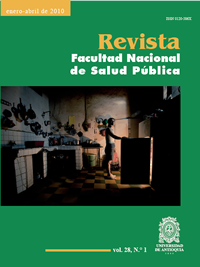La función del embarazo en adolescentes sobre la resignificación de la sexualidad
DOI:
https://doi.org/10.17533/udea.rfnsp.2136Palavras-chave:
adolescencia, resignificación, feminidad, embarazo, hijoResumo
El artículo expone los hallazgos efectuados en la investigación realizada dentro del contexto de la maestría en investigación psicoanalítica del Departamento de Psicoanálisis de la Universidad de Antioquia en el año 2008. Objetivo: responder a la pregunta por la función que cumple un hijo para una mujer adolescente en la resignificación de la sexualidad infantil. Metodología: entrevistas a siete mujeres adolescentes entre los quince y los diecisiete años, cinco embarazadas y dos que ya son madres. Resultados: las adolescentes quedaron embarazadas a partir de su deseo, no por la ignorancia en cuanto a métodos anticonceptivos o a factores externos a ellas. A través del embarazo y de la posterior presencia del hijo, se tramitan asuntos simbólicos que es preciso resolver en la adolescencia: el duelo por los objetos parentales, el cuerpo de la infancia y el rol infantil. Conclusiones: el embarazo y un hijo en la adolescencia le permiten a la joven resignificar la sexualidad infantil, donde están incluidos los objetos más antiguos del sujeto: los parentales. Discusión: estos hallazgos se presentan como novedosos porque aquí se muestra una explicación desde la elección del sujeto, desde su responsabilidad subjetiva.
Downloads
Referências
(1). Castrillón SE. Estado de la cuestión. En: La función de un hijo para una mujer adolescente. Medellín: Trabajo de investigación presentado para optar al título de magister en investigación psicoanalítica, Universidad de Antioquia, Facultad de Ciencias Sociales y Humanas, Departamento de psicoanálisis, 2008.
(2). Unión De Ciudadanas De Colombia. Del fracaso al éxito. Proyecto de capacitación para el desarrollo personal y la generación de ingresos a jóvenes pobres que son madres solas, embarazadas o adolescentes en situación de riesgo en la ciudad de Medellín, Colombia, 2002. p. 7.
(3). Freud S. La metamorfosis de la pubertad. En: Tres ensayos para una teoría sexual. Tomo 2. España: editorial Biblioteca nueva; 2003. p. 1225.
(4). Soler C. Declinaciones de la angustia. Estudios de psicoanálisis. Bogotá: editora Gloria Gómez, Colección Ánfora; 2007. p 139.
(5). Freud S. Tres ensayos para una teoría sexual. Tomo 2. España: editorial Biblioteca Nueva, 2003.
(6). Freud S. La Metamorfosis de la pubertad, en: Tres ensayos para una teoría sexual. Buenos Aires: Amorrortu editores; 1905. p. 206-207.
(7). Freud S. La feminidad, en: Nuevas lecciones Introductorias al Psicoanálisis Tomo 3. España: Editorial Biblioteca Nueva; 2003. p. 3168- 3169.
Downloads
Publicado
Como Citar
Edição
Seção
Licença
Copyright (c) 2021 Sandra Castrillón C.

Este trabalho está licenciado sob uma licença Creative Commons Attribution-NonCommercial-ShareAlike 4.0 International License.
El autor o los autores conserva(n) los derechos morales y cede(n) los derechos patrimoniales que corresponderán a la Universidad de Antioquia, para publicarlo, distribuir copias electrónicas, incluirlas en servicios de indización, directorios o bases de datos nacionales e internacionales en Acceso Abierto, bajo la licencia Creative Commons Atribución-No Comercial-Compartir Igual 4.0 Internacional Comercial (CC BY-NC-SA) la cual permite a otros distribuir, remezclar, retocar y crear a partir de la obra de modo no comercial, siempre y cuando se dé crédito respectivo y licencien las nuevas creaciones bajo las mismas condiciones.












 --
-- --
-- --
--